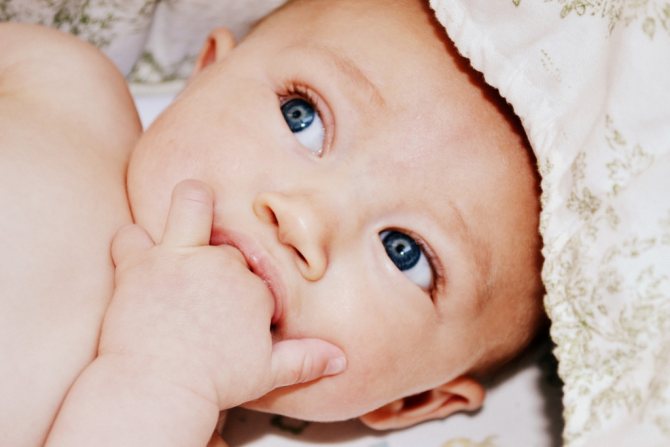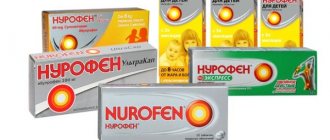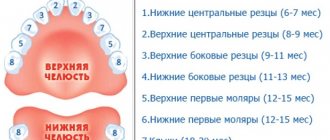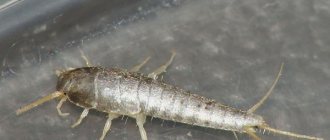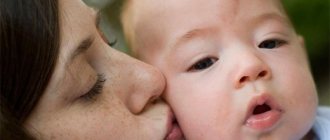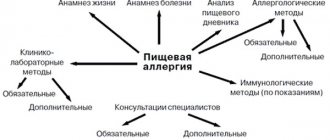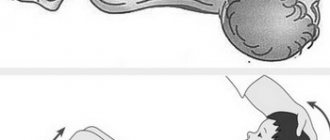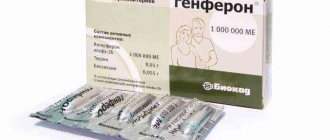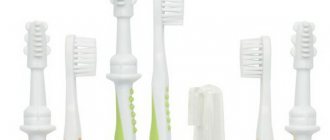How teeth are formed
The appearance of the first tooth is a milestone in a child's development. Now he's almost an adult! After all, his teeth will help him chew solid food and develop speech.
Milk teeth begin to form in the fetus already in the 5th – 6th week of pregnancy. Between the 3rd and 6th months, enamel has already formed on the teeth. All this will be hidden under the gums for the time being. At the same time, deep in the jaw bone there are already the rudiments of molar teeth.
For most children, their first tooth appears between 4 and 7 months, but for some it happens later. With early development, it can erupt at 3 months or earlier. If the child grows normally and has no problems with skin and hair, then it’s okay. But if your baby is already 1.5 years old, and teeth have not appeared, you may need the help of a dentist.
The lower teeth usually appear about a month earlier than the upper teeth.
Approximate order of appearance of baby teeth:
- Lower central incisors (at 6 – 7 months).
- Upper central incisors (at 8 – 9 months).
- Upper lateral incisors (at 9–11 months).
- Lower lateral incisors (at 11 – 13 months).
- Upper small molars (molars) (at 12 – 15 months).
- Lower small molars (molars) (at 12 – 15 months).
- Upper canines (at 16 – 18 months).
- Lower canines (at 18 – 20 months).
- Lower large molars (molars) (at 24 – 30 months).
- Upper large (root) (at 23 – 30 months).
By age 3, your baby should have all 20 teeth, which will last until he is about 6 years old, when his first baby tooth falls out.
Don't be discouraged if your teeth grow crooked at first. Over time they will all fall into place.
When do babies start teething?
Even young parents can guess when the very first teething of babies begins, because this can be determined by many signs. Relatives often become nervous if the children they know have already erupted or are erupting, but their own little one has not.
Infants can erupt their first teeth throughout the year, depending on the following factors:
- From heredity. In infants born from early parents, the first tooth emerges faster than in later ones;
- From the floor. In girls, the first shoots begin to grow faster than in boys;
- From the climate of the area in which the baby lives. The hot climate means that newborns can start cutting at 2 months;
- From the baby's diet. If the baby does not eat well, or his nutrition is not complete and there is a deficiency of calcium in the body, then obviously there is no need to expect that the baby’s first scar will appear at 3 months.
How to understand that your baby is teething (symptoms)
Many people believe that the process of teething must necessarily be accompanied by general anxiety of the baby, fever and diarrhea. However, not all experts share this point of view. Some consider this a mere coincidence. There is an opinion that children, when they start teething, are more likely to put dirty objects in their mouths to scratch their gums, and cause an infection.
Some lucky people go through this period painlessly.
But most children still experience some discomfort:
- Anxiety;
- Increased salivation, which can lead to facial irritation;
- The gums swell and become more sensitive;
- Refusal to eat;
- Bad dream.
If your baby has a fever or diarrhea, consult a doctor.
How to soothe teething pain
To ease the child's suffering, you can massage with something cool. Some people simply massage the gums with their fingers, but you should be careful so that the child does not bite the finger.
You can give him safe foods:
- Raw peeled carrots or frozen banana. Their long pieces easily reach the corners of the gums that hurt the most. But it is not worth leaving the child alone during this process, so that he does not choke.
- You can offer your baby a cold dessert spoon or a frozen cloth, which he will happily suck or chew. In addition, such unusual items will keep the baby busy for a long time.
- A refrigerated teether is also considered a good option .
Pharmacies have a large selection of gels that help with teething. They relieve pain because they contain lidocaine and menthol. But some children may have an allergic reaction to these components.
If gels and other remedies do not help and the child is in severe pain, you can give him a dose of paracetamol. It relieves pain quite effectively. But it’s better to play it safe and consult a doctor so as not to confuse any serious illness with the process of teething.
Read also: The roots of baby teeth are reabsorbing
Each child experiences the teething process differently. But by the age of two and a half, 20 teeth should erupt. They will serve the child until he is six years old, and then a new stage will begin - the loss of milk teeth and the growth of permanent teeth.
How to help your baby when teething
- Give your baby something to chew on, such as a teether, which can be pre-chilled in the refrigerator.
- Massage your baby's gums with a clean finger. You can first wrap your finger in clean gauze. This will relieve the pain for a while.
- If your baby is already eating solids, give him cool foods (applesauce or yogurt).
- You can give your child something hard to chew on, such as a cracker. Just make sure your baby doesn't choke.
- If all of the above does not help, you can give your child a baby pain reliever or a special teething gel - strictly after consulting a doctor.
Vomiting, runny nose and diarrhea are not always symptoms of teething. If your baby appears unwell, call the doctor.
The child loses his appetite
Poor appetite is another alarming symptom for parents, indicating that the baby will soon have his first tooth. This occurs due to pain in the gums, which intensifies while sucking on the breast or bottle.
A sign such as decreased appetite may be accompanied by the following changes in behavior:
- complete or partial refusal of the breast, bottle;
- constant whims during feeding, uncharacteristic arching of the body or twisting of the legs;
- increased desire to put something in the mouth and subsequent refusal to do so due to increased discomfort and itching in the gums;
- loss of interest in solid foods (typical for children on a mixed diet).
Read also: Can there be a cough during teething?

Many young and experienced mothers discuss the problem of diarrhea during teething in young children.
Every day the stool becomes more and more liquid and foamy, this is quite normal.
This happens due to the fact that the baby swallows a large amount of saliva.
Another reason for diarrhea is that the baby puts any toys, pens, clothes, or bedding into his mouth, which are simply strewn with bacteria.
If the stool does not return to normal within three days, then you should definitely contact your pediatrician, because constant diarrhea leads to dehydration of the child’s body. Such long periods indicate that the bacteria that entered the body caused an infectious disease and severe upset of the gastrointestinal tract.
Choosing a toothpaste and brush
Has your baby cut his first tooth? Congratulations!
- Until one year of age, parents need to brush their baby’s teeth without toothpaste using a special silicone brush placed on their finger at least once a day.
- At one year old, the baby needs to pick up his first children's toothbrush - without toothpaste for now. It is better if the child chooses it himself. She should interest him, but not scare him away.
What should you pay attention to when choosing a children's toothbrush?
- Decor - kids love bright colors and funny characters.
- The handle should be comfortable, preferably made of non-slip material with a protective ring to avoid injury. Its length should correspond to the age of the child.
- It is important that the brush head is not too large and awkward. The optimal size is 2–3 teeth of a child. To avoid damaging your gums, it is better to choose a brush with a rounded head.
- Soft brushes with a bristle height of no more than 11 mm are suitable for children. It should be even so that the pressure on the surface of the teeth is uniform.
- From 2 to 2.5 years old, it’s time to start using toothpaste and teach your child to brush his teeth on his own. You need to choose a special children’s toothpaste without fluoride, because the baby may want to eat it. You can switch to fluoride toothpaste when he learns not to swallow it.
Signs of teething
The most important sign of the imminent appearance of the first tooth is increased, profuse salivation. It can begin approximately 1-2 months before the first tooth. It is impossible not to notice this sign: saliva flows constantly, all the clothes on the chest immediately become wet. During this period, bibs will be required.
Like the timing of teething, the accompanying symptoms can be quite varied and individual for different children. For some children, the process of teething is quite difficult and painful, while for others it is almost imperceptible, and a newborn tooth is discovered by parents completely by accident.
Before a tooth erupts, you can find a thin white convex line on the gum that makes a loud click when it comes into contact with a teaspoon. Usually this is how the first tooth is discovered during feeding.
Signs of teething are:
- Swelling, inflammation of the gums, they become painful;
- Irritation on the chin due to excess saliva;
- Partial loss of appetite;
- Sleep disturbances, the child often wakes up, sometimes screaming;
- The desire to chew on any objects that come into your hands, to constantly keep your fingers in your mouth;
- The child becomes restless, capricious and whiny.
Sometimes, against the background of teething, a child may experience a fever, wet cough, runny nose, and diarrhea.
The increase in temperature is associated with the release of a large amount of biologically active substances in the tooth growth zone. An increase in temperature during teething should not last more than 1-2 days and exceed 38.5º C. To bring down the temperature, you can use Paracetamol.
If the temperature exceeds 39º C and lasts more than two days, the child should be shown to a doctor.
The appearance of diarrhea is explained by strong salivation (the child in this case swallows a lot of saliva) and increased (accelerated) intestinal motility.
Diarrhea due to teething is watery, infrequent (2-3 times a day) and lasts no more than 1-3 days. If frequent watery or bloody diarrhea (more than 3 times a day), characteristic of an intestinal infection, it is necessary to show the child to a doctor.
The appearance of a runny nose is explained by increased secretion of mucus by the nasal glands. The mucus during a runny nose due to teething is watery, transparent and runny, the runny nose is not very profuse and lasts no more than 3-4 days. When treating it, you can limit yourself to clearing the nose of phlegm.
If you experience a profuse purulent (whitish, greenish) runny nose that lasts more than 3 days, and severe nasal congestion, you need to consult a doctor.
The appearance of a wet cough is explained by the accumulation of a large amount of saliva in the throat. This is a fairly rare symptom for teething. The cough worsens when lying down, lasts no more than 2-3 days, and does not require any treatment.
If a wet cough becomes frequent, is accompanied by copious sputum, shortness of breath, wheezing in the bronchi and lasts more than 2 days, you should call a doctor.
Parents should be very careful not to confuse signs of teething with any disease. One tooth usually erupts within 2-3 days, sometimes up to a week. At this time, you need to be understanding of the child’s whims.
How to brush your teeth correctly
- Your baby's teeth need to be brushed 2 times a day - in the morning and in the evening before bed.
- Use a small amount of toothpaste at first, about the size of a grain of rice, then work up to a pea-sized amount.
- If you use such a small amount of toothpaste, there is no need to rinse your mouth.
- Brush your teeth gently from the outside and inside.
- The tongue also needs to be cleaned, because bacteria accumulate on it, causing bad breath.
- Remember to change your toothbrush every 3 months.
At this stage, it is too early to floss because the teeth are usually far apart.
Creating a good habit
The habit of brushing your teeth should be established in childhood. If you don’t force your child, but figure out how to turn this activity into an interesting game, your baby will brush his teeth with pleasure. Here are some tips:
- Children love to copy adults, so lead by example by brushing your teeth with your child.
- If you brush your teeth with your baby, at the end open your mouth and show each other how you handled this “task.” If necessary, clean your child's teeth yourself.
- Don't scold him, no matter how badly he cleaned it. Children at this age have not yet developed fine motor skills, so do not expect precise movements from them.
- Let your child associate brushing his teeth with something joyful. Play his favorite children's music, tell him stories about teeth, and draw on a dental theme.
- Keep a piece of paper with a schedule for brushing your teeth. Divide the day into morning and evening (you can draw the sun and moon there) and check the box when you brush your teeth.
- Finally, talk to your child like an adult. Explain to him why brushing his teeth is good. Draw scary microbes on a piece of paper and together figure out how you can fight them.
If your little one refuses to brush his teeth, try buying him a new toothbrush with his favorite cartoon character on it. Get him interested. Get several toothbrushes and let him choose a new one each time.
What microelements are needed for teeth growth?
Fluorine
Fluoride strengthens tooth enamel, making it more resistant to acids and harmful bacteria. Thus, it helps prevent the development of caries.
Fluorine is found in:
- Toothpaste - however, remember that toothpaste with a small fluoride content can only be used by children over 4 years old;
- Fluoride-enriched water;
- Chewable tablets or drops;
- Some fruit juices.
Remember that too much fluoride can lead to fluorosis, which is when white spots appear on the teeth. Therefore, it is important not to use too much toothpaste, especially if the child has not yet learned to spit it out.
Calcium
Calcium takes an active part in the mineralization of teeth. A 3-year-old child should receive 800–1100 mg of calcium per day.
Products containing calcium:
- Milk, yogurt;
- Spinach and other green leafy vegetables;
- Broccoli;
- Fish.
In order for calcium to be better absorbed, it needs helpers. One is vitamin D and the other is vitamin K2.
Vitamin K
Calcium is collected and transported into bone tissue using the protein osteocalcin, which normally “dormants” peacefully in the blood. In order to activate it, you need natural vitamin K. It is found in dairy products (milk, yogurt, kefir, cottage cheese - for example, Agusha K2 cottage cheese).
When should I take my child to the dentist?
The Ministry of Health of the Russian Federation recommends showing a child to the dentist once a year starting from 12 months.
The purpose of the first trip to the dentist is prevention. The doctor checks whether teeth are growing correctly and gives recommendations on oral hygiene. It is better to do this no later than your first birthday, so that the specialist does not miss caries and possible problems with your bite.
The first trip to the dentist should not frighten your child.
Here are some tips to make it painless:
- Do not pay too much attention to this event, do not prepare your child on purpose;
- Don’t worry yourself so that your baby doesn’t get nervous along with you;
- If possible, arrive early to your appointment to give your baby time to look around.
Symptoms of teething in infants
A sign that teeth are “on the way” is:
- Swelling and redness of the gums. They acquire a loose structure and may bleed a little. Shortly before the tooth comes out, it can already be felt.
- Increased body temperature . Usually it is insignificant - up to 37.5°C. But if the temperature is high, this means that the baby’s weakened body has simultaneously picked up a viral or bacterial infection.
- Strong salivation and itching in the gum area. You may notice that the child puts everything into his mouth, gnaws, and scratches his gums with various objects or fingers. In order to once again stretch the gums, the child may ask to be put to the breast more often or to suck on a bottle.
- Nasal congestion and runny nose. Sometimes excessive salivation causes excess mucus to leak through the nose. But this can also indicate the presence of an infection in the body.
- Cough. Excess mucus flows down the back wall of the baby's throat, thereby irritating it.
- Refusal to eat and problems with digestion , as the pain is very strong.
- The behavior becomes uncharacteristic of the baby. The child becomes capricious and irritable. Because of this, sleep suffers, and the baby’s nervous system does not rest well. The baby often cries and moans in his sleep.
- Diarrhea and vomiting. Many parents notice an upset stomach in their baby due to teething. However, this symptom should alert you. The baby’s immune system weakens and you can easily catch an intestinal or rotavirus infection. It is better to clarify this point with your pediatrician; he will figure everything out.
- The downside of teething indigestion is constipation . If this symptom cannot be eliminated on your own by correcting your diet, go back to the doctor, just don’t delay.
- Irritation and rash on the cheeks are normal with excessive salivation. If the rash appears on other parts of the body, see a doctor immediately.
